Macedonian Struggle
The Macedonian Struggle (Bulgarian: Македонска борба; Greek: Μακεδονικός Αγώνας; Macedonian: Борба за Македонија; Serbian: Борба за Македонију; Turkish: Makedonya Mücadelesi) was a series of social, political, cultural and military conflicts that were mainly fought between Greek and Bulgarian subjects who lived in Ottoman Macedonia between 1893 and 1912. The conflict was part of a wider guerilla war in which revolutionary organizations of Greeks, Bulgarians and Serbs all fought over Macedonia. Gradually the Greek and Bulgarian bands gained the upper hand. Though the conflict largely ceased by the Young Turk Revolution, it continued as a low intensity insurgency until the Balkan Wars.
| Macedonian Struggle | |||||||
|---|---|---|---|---|---|---|---|
| Part of the decline of the Ottoman Empire | |||||||
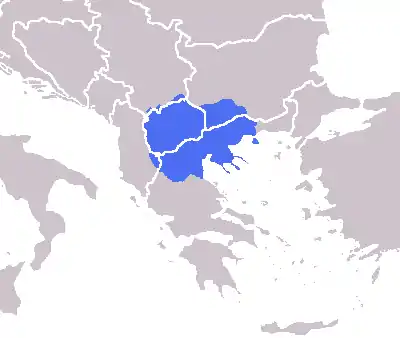 The geographical region of Macedonia as defined in the 1800s | |||||||
| |||||||
| Belligerents | |||||||
|
Supported by: |
| ||||||
| Commanders and leaders | |||||||
|
|
| ||||||
| Casualties and losses | |||||||
| 8,000 militants and civilians killed (1903–1908)[2] | |||||||
Background
Initially the conflict was waged through educational and religious means, with a fierce rivalry developing between supporters of the Ecumenical Patriarchate of Constantinople (Greek-speaking or Slavic/Romance-speaking people who generally identified as Greek), and supporters of the Bulgarian Exarchate, which had been recognized by the Ottomans in 1870.[3]
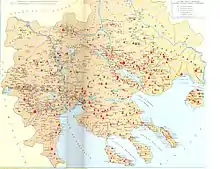
As Ottoman rule in the Balkans crumbled in the late 19th century, competition arose between Greeks and Bulgarians (and to a lesser extent also other ethnic groups such as Serbs, Aromanians and Albanians) over the multi-ethnic region of Macedonia.[3] The Bulgarians founded the Internal Macedonian Revolutionary Organization in 1893 which coordinated the majority of Bulgarian actions in the region. The defeat of Greece in the Greco-Turkish War of 1897 was a loss that appalled Greeks[4] which led to the dissolution of the Ethniki Eteria, by Prime Minister Georgios Theotokis. With little prospect of liberation by Greece, the Macedonian Greeks took their fate into their own hands and began to form various armed bands that would ultimately fall under the control of the Hellenic Macedonian Committee. The region quickly became a constant battleground among various armed groups, with hostilities peaking in 1904-1908. The Ottoman Army was also involved in the conflict and perpetuated atrocities against the Christian population in attempt to quell the unrest. Due to the Christian population of Macedonia, whether Greek, Serb, Bulgarian or Aromanian, engaging in more or less constant rebellion against the Ottoman Empire, in conjunction with the revolutionary activities of Armenian nationalists in Anatolia, many Ottoman officers believed that all Christians of the empire were disloyal and treasonous.[5]
Bulgarian Activity
Internal Macedonian Revolutionary Organisation

In 1893, the Bulgarian Internal Macedonian Revolutionary Organization (IMRO) had been founded in Thessaloniki.[6][7][8] It self-identified as being representative of all nations in Macedonia, along with anti-Ottoman revolutionaries, with the aim of freeing Macedonia and Thrace from Ottoman rule, potentially to unite with Bulgaria.[9][10][11] The IMRO was declared as a Macedonian organization open to all ethnic groups in Macedonia and, earlier on, IMRO claimed that it was fighting for the autonomy of Macedonia and not for annexation to Bulgaria. However, according to some authors and historians, it later became an agent serving Bulgarian interests in Balkan politics with the aim of eventually uniting the entirety of Macedonia with Bulgaria, first in struggles against the Ottoman Empire and later against the Serbian-led Yugoslav successor state controlling the territory of Vardar Macedonia and the Greek state which controlled the southern portion of the region.[12] One major event representing the culmination of these actions is the assassination of the Serbian King of the Kingdom of Serbs, Croats and Slovenes during the inter-war period by an IMRO sniper, likely working for Bulgarian interests. In practice, most of the followers of the IMRO were local Macedonian Bulgarians, though they also had some Aromanian allies or pro-Bulgarian supporters,[13][14][15] like Pitu Guli, Mitre The Vlach, Ioryi Mucitano and Alexandru Coshca.[16] Many of the members of the organization saw Macedonian autonomy as an intermediate step to unification with Bulgaria,[17] but others saw as their aim the creation of a Balkan federal state, with Macedonia as an equal member.[18]The IMRO ultimately weakened due to a split into a left-wing faction (federalist) and a right-wing faction (centralists) following the failed Ilinden–Preobrazhenie Uprising.
Bulgarian Efforts
Already from 1895 the Supreme Macedonian-Adrianople Committees were formed in Sofia in order to reinforce the Bulgarian actions in Ottoman Empire. One of Komitadjis' first activities was the capture of the predominantly Greek town of Meleniko (today Melnik, Bulgaria), but they couldn't hold it for more than a few hours.[19][20] Bulgarian bands destroyed the Pomak village of Dospat where they massacred local inhabitants.[20] This kind of activity alerted Greeks and Serbians, who made a farce of the slogan "Macedonia to Macedonians", being against the constitution of Macedonia as separate state.[21]
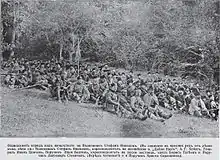
As Bulgarian efforts intensified, they started to affect European public opinion. In April 1903, a group known as the Boatmen of Thessaloniki, with assistance from the IMRO, blew up the French ship Guadalquivir and the Ottoman Bank in Thessaloniki. In August 1903, the IMRO organised the Ilinden Uprising in Macedonia and the Adrianople Vilayet which led to the formation of the short-lived Kruševo Republic. The uprising was ultimately suppressed by the Ottoman Army with the subsequent destruction of many villages and the devastation of large areas in Western Macedonia and around Kırk Kilise near Adrianople.
Greek Activity
Hellenic Macedonian Committee
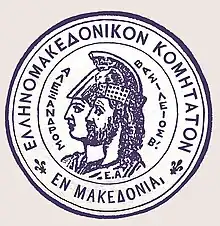
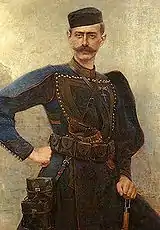
In order to strengthen Greek efforts for Macedonia, the Hellenic Macedonian Committee was founded in 1903 by Stefanos Dragoumis and functioned under the leadership of wealthy publisher Dimitrios Kalapothakis. Its members included many Greek notables in addition to the fighters. Among its members were Ion Dragoumis and Pavlos Melas.[22] Its fighters were known as Makedonomachoi ("Macedonian fighters").[23]
Under these conditions, in 1904 a vicious guerrilla war broke as response of IMRO activities between Bulgarian and Greek bands within Ottoman Macedonia. The Bishop of Kastoria, Germanos Karavangelis, who was sent to Macedonia by Nikolaos Mavrokordatos, the ambassador of Greece, and Ion Dragoumis, the consul of Greece in Monastir, realised that it was time to act in a more efficient way and began to organise the intensification of the Greek opposition.
While Dragoumis concerned himself with the financial organisation of the efforts, the central figure in the military struggle was the very capable Cretan officer Georgios Katechakis.[24] Bishop Germanos Karavangelis travelled to raise morale and encourage the Greek population to take action against the IMRO. Many committees were also formed to promote the Greek national interests.
Katechakis and Karavangelis succeeded in the recruitment and organization of guerrilla groups that were later reinforced with volunteers from Greece. Volunteers often came from Crete and the Mani area of the Peloponnese. They even recruited former IMRO members, taking advantage of their political and/or personal disputes within the organisation. Additionally, officers of the Hellenic Army were encouraged to join the struggle to provide experienced leadership, as many had served in the Greco-Turkish War of 1897. The officers who elected to join provided a logistical advantage to the Makedonomachoi. The Macedonian Greeks, however, would form the core of the fighting force and proved to be the most important fighters due to their knowledge of the region's geography and some possessing knowledge of the Bulgarian language. Many local Greeks, such as Periklis Drakos, were also involved in the smuggling and stashing of weapons and ammunition around the region.
Greek Efforts

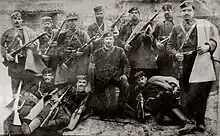
The Greek state became concerned, not only because of Bulgarian penetration in Macedonia but also due to Serbian interests, which were concentrated mainly in Üsküp and Monastir area. The rioting in Macedonia, especially the death of Pavlos Melas in 1904, caused intense nationalistic feelings in Greece. This led to the decision to send more volunteers to reinforce and better organise the armed bands and thwart the Bulgarian efforts to bring all of the Slavic-speakers of Macedonia on under their influence.
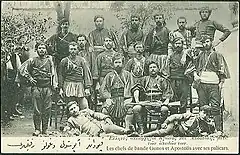
The Greek General Consulate in Thessaloniki, under Lambros Koromilas, became the centre of the struggle, coordinating the Greek bands, distributing, and nursing the wounded. Fierce conflicts between the Greeks and Bulgarians started in the area of Kastoria, in the Giannitsa Lake area, and elsewhere. During 1905, guerilla activity increased and the Makedonomachoi gained significant advantage within 10 months, extending their control towards the areas of Mariovo and East Macedonia, Kastanohoria (near Kastoria), the plains north and south of Florina and the routes around Monastir.[25] However, from early 1906 the situation became critical and the forces of the Makedonomachoi were forced to withdraw from various areas. Nevertheless, the groups of Tellos Agras and Ioannis Demestichas had some success in the marsh of Giannitsa.[25] There were great advances of the Serb forces, joined by Muslim Slavs, in summer of 1906 in the northern areas of the Sanjak of Üsküp.[26]
While the armed bands confronted the Ottoman Army, the Ottoman administration often ignored the activities of the Greek guerrillas,[27] and according to Dakin assisted them against the Bulgarians outright.[21] However, once the subversive potential of the Bulgarians had been neutralised, Ottoman policy ended the favourable neutrality to the Greek side and embarked upon relentless persecutions against the Greeks.[28] During the course of the conflict Greek armed bands numbered 2,000 men. Of whom over 700 were killed in action along with 1,250 pro-Greek civilians. [29]
Aromanian activity
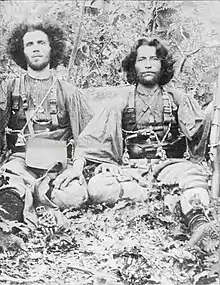
The Greek–Romanian conflict concerning the Aromanians reached its climax during the Macedonian Struggle, with Aromanians being no longer divided into pro-Greek and pro-Romanian factions but into "Greeks" and "Romanians" proper.[30] The pro-Greek faction was the largest and most powerful.[31]
Pro-Greek Aromanians
Most Aromanians during the Macedonian Struggle were pro-Greek, supporting the Greek revolutionaries and the Ecumenical Patriarchate of Constantinople.[30][31][32] These Aromanians escaped or resisted the influence of Romanian interventionism,[33] in which a considerable amount of money was spent on by the Romanian state.[34] They were indifferent or even hostile to their national movement.[30] In the archives of the Greek Foreign Ministry there are numerous testimonies from Aromanian communities denouncing Romanian "propaganda" and proclaiming their Greekness.[34] In Veria, there was a small local unit which was under the leadership of a pro-Greek Aromanian, Tasos Koukotegos. This unit, being small and somewhat isolated, had been operating without definite objectives, but it proved to be very important for the Greek cause as it helped in fights against local Turkish chiefs, pro-Romanian Aromanians, and Bulgarian komitadjis.[34] Additionally, local support from pro-Greek Aromanians in Kastoria empowered Greek activity in the region.[34] A notable Greek makedonomachos of Aromanian descent was Anastasios Pichion.

In Pelagonia, the pro-Greek sentiments of Aromanians during the Macedonian Struggle contributed to their displacement.[35] When they migrated to Greece, they were already financially ruined.[36]
Pro-Romanian Aromanians
As the Bulgarians had managed to introduce their language in church services and education in the Ottoman Empire, so did the pro-Romanian Aromanians start demanding the same rights. The Greek Ecumenical Patriarch of Constantinople reacted strongly to this however amid increased rivalry in the region and eight Aromanian churches were closed by his personal order in 1875. This produced protests from the pro-Romanian Aromanians to the Ottoman and Romanian government, and also increased tensions between the pro-Romanian Aromanians and the Greeks[37] as well as with pro-Greek Aromanians,[38] which led to physical violence that often ended in fatalities.[37]
In 1903, following the failure of the Ilinden–Preobrazhenie Uprising in which many pro-Romanian Aromanian and Bulgarian soldiers had fought with the aim of creating a Macedonian autonomy, the Ottoman Empire allowed the intervention of Greek militias, known as antartes and formed within Greece with commanders from the Greek state, to suppress potential renewed attempts of this objective. These commanders began to threaten the leaders of various Romanian schools in Aromanian villages, warning them that if they did not close down their activities, they would be attacked. Given this, some pro-Romanian Aromanian fighters referred to as armatoles (armatoli, armatol in singular) began to take up arms, the first ones being Mihail Handuri from Livadia (Giumala de Jos or Livãdz) and Hali Joga from Ano Grammatiko (Grãmãticuva), who having been joined by various young pro-Romanian Aromanian fighters, began to attack Greek bands in the area of Edessa and Veria. These pro-Romanian Aromanian bands were allied with Bulgarian bands in Ottoman Macedonia. In 1906, under Ioryi Mucitano,[39] they were organized into two committees, one in Bucharest led by Alexandru Coshca and Sterie Milioru and the other in Sofia led by Mucitano. He decided to divide their area of operations into districts led by a so-called voivode. These bands were allowed free passage by Bulgarian villages.[40]
Clashes
Starting from summer of 1904, clashes between pro-Romanian Aromanian and ethnic Greek[40] or pro-Greek Aromanian bands,[38] be it only between themselves or with other combatants involved, erupted in the village of Condusula (between Edessa and Naousa), Ano Grammatiko,[40] Pyrgoi and Dervent.[41] Pro-Greek schools and churches were destroyed by the pro-Romanian Aromanians and pro-Greek Aromanians retaliated by doing the same to pro-Romanian schools and churches.[42] The two factions expelled each other and even murdered opponent schoolteachers and clergy.[42] One such case took place in 1911, when a unit of pro-Romanian Aromanians murdered Emilianos Lazaridis, Metropolitan of Grevena, for promoting the assimilation of the Aromanians into the Greek nation.[43] Another example is Haralambie Balamaci, an Aromanian priest murdered in 1914 by Greek forces.[44]
Greeks and pro-Greek Aromanians suffered attacks from Turkish troops and bashibazouks who killed 41 of them and destroyed 366 and 203 of their houses and shops respectively.[34]
Crimes
War crimes were committed by both sides during the Macedonian struggle. According to a 1900 British report compiled by Alfred Biliotti, who is considered to have heavily relied on Greek intelligence agents,[45] starting from 1897, the members of the Exarchist committees had embarked upon a systematic and extensive campaign of executions of the leading members of the Greek side.[46] Moreover, Bulgarian Komitadjis, pursued a campaign of extermination of Greek and Serbian teachers and clergy.[47] On the other hand, there were attacks by Greek Andartes on many Macedonian Bulgarian villages, with the aim of forcing their inhabitants to switch their allegiance from the Exarchate back to the Patriarchate and accept Greek priest and teachers,[48] but they also carried out massacres against the civilian population,[49] especially in the central parts of Macedonia in 1905[50] and in 1906.[51] One of the notable cases was the massacre[52] at the village Zagorichani (today Vasiliada, Greece), which was a Bulgarian Exarchist stronghold[21] near Kastoria on 25 March 1905, where between 60 and 78 villagers were killed by Greek bands.[51][53]
According to British reports on political crimes (including the above-mentioned Biliotti report), during the period from 1897 to 1912 over 4000 political murders were committed (66 before 1901, 200 between 1901 and 1903, 3300 between 1903 and 1908 and 600 between 1908 and 1912), excluding those killed during the Ilinden Uprising and the members of the Bulgarian and Greek bands. Of those who were killed, 53% were Bulgarians, 33.5% were Greeks, Serbs and Aromanians together 3.5% and 10% were of unknown ethnicity.[54]
These conflicts decreased their intensity after the revolution of Young Turks in July 1908, as they promised to respect all ethnicities and religions, and to provide a constitution.
Consequences
The success of Greek efforts in Macedonia was an experience that gave confidence to the country. It helped develop an intention to annex Greek-speaking areas, and bolster Greek presence in the still Ottoman ruled Macedonia.
The events in Macedonia, specifically the consequences of the conflicts between Greek and Bulgarian national activists, including Greek massacres against the Bulgarian population in 1905 and 1906, gave rise to pogroms against the ca. 70,000-80,000 strong Greek communities that lived in Bulgaria, who were considered to share responsibility for the actions of the Greek guerrilla groups.[53][55]
Nevertheless, the Young Turk movement resulted in a few instances of collaboration between Greek and Bulgarian bands, while this time the official policy in both countries continue to support the penetration of armed fighters into Ottoman Macedonia, but without having fully ensured that there would be no attacks on each other.[56]
Legacy
Greek writer Penelope Delta wrote the novel Τά μυστικά τοῦ Βάλτου (Ta Mystiká tou Váltou – The Secrets of the Swamp) about the fighting around the Giannitsa Lake.
Germanos Karavangelis published his memoirs as Ὁ Μακεδονικός Ἀγών (The Macedonian Struggle).
The 1973 Greek film Pavlos Melas depicts the life and death of Pavlos Melas.
Albert Sonnichsen, an American volunteer in the IMRO depicted Bulgarian activities in the book Confessions of a Macedonian Bandit: A Californian in the Balkan Wars.
Many museums have been dedicated to the conflict, including those in Thessaloniki (housed in the former Greek consulate), Kastoria, Chromio, and Skopje.
Notes
- Sfetas, Spyridon (2001). "Το ιστορικό πλαίσιο των ελληνο-ρουμανικών πολιτικών σχέσεων (1866-1913)" [The Historical Context of Greco-Romanian political relations (1866–1913)]. Makedonika (in Greek). Society for Macedonian Studies. 33 (1): 23–48. doi:10.12681/makedonika.278. ISSN 0076-289X. Retrieved 8 May 2017.
- Ryan Gingeras: The Last Days of the Ottoman Empire, Penguin Random House, 2022, ISBN 978-0-241-44432-0.
- Clogg, Richard. A Concise History of Greece. Cambridge University Press, 1992. 257 pp. p.81.
- Clogg, Richard. A Concise History of Greece. Cambridge University Press, 1992. p. 71.
- Akmeşe 2005, pp. 50–53.
- The revolutionary committee dedicated itself to fight for "full political autonomy for Macedonia and Adrianople." Since they sought autonomy only for those areas inhabited by Bulgarians, they denied other nationalities membership in IMRO. According to Article 3 of the statutes, "any Bulgarian could become a member". For more see: Laura Beth Sherman, Fires on the mountain: the Macedonian revolutionary movement and the kidnapping of Ellen Stone, Volume 62, East European Monographs, 1980, ISBN 0914710559, p. 10.
- "As a Bulgarian historian, Pandev underlined the fact that, since its foundation the organization chose its Bulgarian identity by selecting the name “Bulgarian revolutionary committees." For more see: Nadine Lange-Akhund, The Macedonian Question, 1893-1908, from Western Sources, 1998 ISBN 9780880333832, p. 39.
- The IMARO activists saw the future autonomous Macedonia as a multinational polity, and did not pursue the self-determination of Macedonian Slavs as a separate ethnicity. Therefore, Macedonian (and also Adrianopolitan) was an umbrella term covering Bulgarians, Turks, Greeks, Vlachs, Albanians, Serbs, Jews, and so on. While this message was taken aboard by some Vlachs as well as some Patriarchist Slavs, it failed to impress other groups for whom the IMARO remained the ‘‘Bulgarian Committee.’’ For more see: Bechev, Dimitar. Historical Dictionary of the Republic of Macedonia, Historical Dictionaries of Europe, Scarecrow Press, 2009, ISBN 0810862956, Introduction.
- Anastasia Karakasidou, Fields of Wheat, Hills of Blood: Passages to Nationhood in Greek Macedonia, 1870–1990, University of Chicago Press, 2009, ISBN 0226424995, p. 100.
- İpek Yosmaoğlu, Blood Ties: Religion, Violence and the Politics of Nationhood in Ottoman Macedonia, 1878–1908, Cornell University Press, 2013, ISBN 0801469791, p. 16.
- Dimitris Livanios, The Macedonian Question: Britain and the Southern Balkans 1939-1949, Oxford Historical Monographs, OUP Oxford, 2008, ISBN 0191528722, p. 17.
- Encyclopedia of terrorism, Cindy C. Combs, Martin W. Slann, Infobase Publishing, 2009, ISBN 1438110197, p. 135.
- Andrew Rossos, Macedonia and the Macedonians: A History, Hoover Press, 2013, ISBN 081794883X,p. 105.
- Philip Jowett, Armies of the Balkan Wars 1912–13: The priming charge for the Great War, Bloomsbury Publishing, 2012, ISBN 184908419X, p. 21.
- Raymond Detrez, 2014, Historical Dictionary of Bulgaria, Rowman & Littlefield, ISBN 1442241802, p. 520.
- "The Aromanians and IMRO (Nikola Minov) - Republic of Macedonia - Balkans". Scribd.
- Идеята за автономия като тактика в програмите на национално-освободителното движение в Македония и Одринско (1893-1941), Димитър Гоцев, 1983, Изд. на Българска Академия на Науките, София, 1983, c. 34.; in English: The idea for autonomy as a tactics in the programs of the National Liberation movements in Macedonia and Adrianople regions 1893-1941", Sofia, Bulgarian Academy of Sciences, Dimitar Gotsev, 1983, p 34. Among others, there are used the memoirs of the IMRO revolutionary Kosta Tsipushev, where he cited Delchev, that the autonomy then was only tactics, aiming future unification with Bulgaria. (55. ЦПА, ф. 226); срв. К. Ципушев. 19 години в сръбските затвори, СУ Св. Климент Охридски, 2004, ISBN 954-91083-5-X стр. 31-32. in English: Kosta Tsipushev, 19 years in Serbian prisons, Sofia University publishing house, 2004, ISBN 954-91083-5-X, p. 31-32.
- Maxwell, Alexander. “Slavic Macedonian Nationalism: From 'Regional' to 'Ethnic.'” Ethnologia Balkanica 11 (2007): 127–55. p. 141.
- Sherman, Laura Beth (1980). Fires on the mountain: the Macedonian revolutionary movement and the kidnapping of Ellen Stone. New York: Columbia U.P. p. 15. ISBN 978-0-914710-55-4.
- "Le meurtre du prêtre comme violence inaugurale (Bulgarie 1872, Macédoine 1900)". http://balkanologie. IX (1–2). December 2005. Retrieved 9 April 2012.
- Dakin, Douglas (1966). The Greek struggle in Macedonia, 1897-1913. Institute for Balkan Studies. pp. 48, 224 and p.337.
- Konstantinos Vakalopoulos, Historia tou voreiou hellenismou, vol 2, 1990, pp. 429-430
- Keith S. Brown; Yannis Hamilakis (2003). The Usable Past: Greek Metahistories. Lexington Books. p. 79. ISBN 978-0-7391-0384-5.
- Bulgarian Historical Review, vol 31, 1-4, 2003, p 117 "Only a few days later -on November 1- Katehakis arrived in Macedonia as Melas' successor"
- Gounaris, Basil C. "National Claims, Conflicts and Developments in Macedonia, 1870-1912" (PDF). macedonian-heritage.gr. p. 194. Retrieved 8 May 2012.
- Vemund Aarbakke (2003). Ethnic rivalry and the quest for Macedonia, 1870-1913. East European Monographs. p. 141. ISBN 978-0-88033-527-0.
- M. Şükrü Hanioğlu (8 March 2010). A Brief History of the Late Ottoman Empire. Princeton University Press. p. 134. ISBN 978-1-4008-2968-2.
- Gounaris, Basil C. "National Claims, Conflicts and Developments in Macedonia, 1870-1912" (PDF). macedonian-heritage.gr. p. 196. Retrieved 8 May 2012.
- Christopoulos & Bastias 1977, p. 254.
- Kahl, Thede (2002). "The Ethnicity of Aromanians after 1990: the Identity of a Minority that Behaves like a Majority". Ethnologia Balkanica (6): 145–169 – via Central and Eastern European Online Library.
- Clogg, Richard (2002). Minorities in Greece: Aspects of a Plural Society. Hurst. p. 118. ISBN 978-1-85065-705-7.
- Kofos, Evangelos (1989). "National Heritage and National Identity in Nineteenth- and Twentieth-Century Macedonia". European History Quarterly. 19 (2): 229–267. doi:10.1177/026569148901900205. ISSN 0265-6914. S2CID 145106821.
- Chenoweth, Erica; Lawrence, Adria (27 August 2010). Rethinking Violence: States and Non-State Actors in Conflict. MIT Press. pp. 107–108. ISBN 978-0-262-26575-1.
- Dakin, Douglas (1966). The Greek struggle in Macedonia, 1897-1913. Institute for Balkan Studies. pp. 26, 103, 217, 309, 365–366.
- Asterios I. Koukoudēs, (2003), The Vlachs: Metropolis and Diaspora. Zitros p. 469
- Asterios I. Koukoudēs, (2003), The Vlachs: Metropolis and Diaspora. Zitros p. 470
- Arslan 2003, p. 81.
- Kofos, Evangelos (1964). Nationalism and Communism in Macedonia. Institute for Balkan studies. p. 314.
- Nicea 2001, p. 4.
- Nicea 2001, p. 5.
- Nicea 2001, p. 6.
- Sawayanagi, Nanako Murata (2010). "Greek Communities Relocated in the Making of the Balkan Nations: The Greek Parliament's Tackling of Refugee Settlement and Land Distribution in Thessaly (1906-1907)". Annals of Japan Association for Middle East Studies. 26 (2): 151–184. doi:10.24498/ajames.26.2_151.
- The Greek collaborationists, designers and leaders of the genocide in Chameri (1944-1945). p. 63.
- Modiga, Iulia (25 March 2019). "Comemorarea martirilor din Balcani. 105 ani de la martirizarea părintelui Haralambie Balamaci". InfoPrut (in Romanian).
- David Barchard, The Fearless and Self-Reliant Servant: The Life and Career of Sir Alfred Biliotti (1833-1895), p.50
- Gounaris, Basil C. "National Claims, Conflicts and Developments in Macedonia, 1870-1912" (PDF). macedonian-heritage.gr. p. 189. Retrieved 8 May 2012.
- Jezernik, Božidar (2004). Wild Europe: the Balkans in the gaze of Western travellers. London: Saqi [u.a.] p. 183. ISBN 978-0-86356-574-8.
- Hazell's Annual. Hazell, Watson and Viney. 1908. p. 574.; Edmund Burke (1907). The Annual Register of World Events: A Review of the Year. Vol. 148. Longmans, Green. p. 334.
- The Encyclopedia Americana: A Library of Universal Knowledge. Vol. 27. Encyclopedia Americana Corporation. 1920. p. 194.
- Henry Noël Brailsford (1906). Macedonia; its races and their future. Metheun. pp. 215–216.
- Theodora Dragostinova (17 March 2011). Between Two Motherlands: Nationality and Emigration among the Greeks of Bulgaria, 1900–1949. Cornell University Press. pp. 39–40. ISBN 978-0-8014-6116-3.
- Great Britain. Parliament. House of Commons (1906). Parliamentary Papers, House of Commons and Command. Vol. 137. H.M. Stationery Office. p. 24.
- The Macedonian question, 1893-1908, from Western sources; Nadine Lange-Akhund; 1998 p.279
- Basil C. Gounaris; Preachers of God and martyrs of the Nation: The politics of murder in Ottoman Macedonia in the early 20th century; Balkanologie, Vol. IX, December 2005
- Theodora Dragostinova (2011). Between Two Motherlands: Nationality and Emigration Among the Greeks of Bulgaria, 1900-1949. Cornell University Press. pp. 66–. ISBN 978-0-8014-6116-3.
New Greek massacres of Bulgarians in Macedonia in 1906 led to a repetition of anti-Greek violence in the Principality of Bulgaria
- Gounaris, Basil C. "National Claims, Conflicts and Developments in Macedonia, 1870-1912" (PDF). macedonian-heritage.gr. p. 201. Retrieved 8 May 2012.
References
- Akmeşe, Handan Nezir (2005). The Birth of Modern Turkey: The Ottoman Military and the March to World War I. London: IB Tauris.
- Arslan, Ali (2003). "Greek-Vlach conflict in Macedonia". Études balkaniques (2): 78–102.
- Christopoulos, Georgios; Bastias, Ioannis (1977). Ιστορία του Ελληνικού Εθνους: Νεώτερος Ελληνισμός απο το 1881 ως 1913 [History of the Greek Nation: Modern Greece from 1881 until 1913] (in Greek). Vol. XIV. Athens: Ekdotiki Athinon.
- Dakin, Douglas: "The Greek Struggle in Macedonia 1897–1913", 1993 ISBN 9607387007
- Karavangelis, Germanos: "The Macedonian Struggle" (Memoirs)* Koliopoulos, Ioannis: History of Greece from 1800, Nation, State and Society, Thessaloniki, 2000 ISBN 960-288-072-4
- Nicea, Cola (2001). "Memorii" (PDF). Scara – revistă de oceanografie ortodoxă (in Romanian) (7): 1–32.
- Rappoport, Alfred: Au pays des martyrs. Notes et souvenirs d'un ancien consul-général d'Autriche-Hongrie en Macédoine (1904–1909). Librarie Universitaire J. Gamber, Paris, 1927. Memoirs of the General Consul of Austro-Hungary in Macedonia. Cat. No. 7029530203814.
- Richards, Louise Parker (November 1903). "What the Macedonian Trouble Is". The World's Work: A History of Our Time. VII: 4066–4073. Retrieved 10 July 2009.
- Sonnichsen, Albert: Confessions of a Macedonian Bandit: A Californian in the Balkan Wars, The Narrative Press, ISBN 1-58976-237-1 (the Macedonian struggle from a perspective of an American volunteer in IMRO)
- Vakalopoulos, Apostolos: "History of the Greek Nation 1204–1985" (in Greek language)


